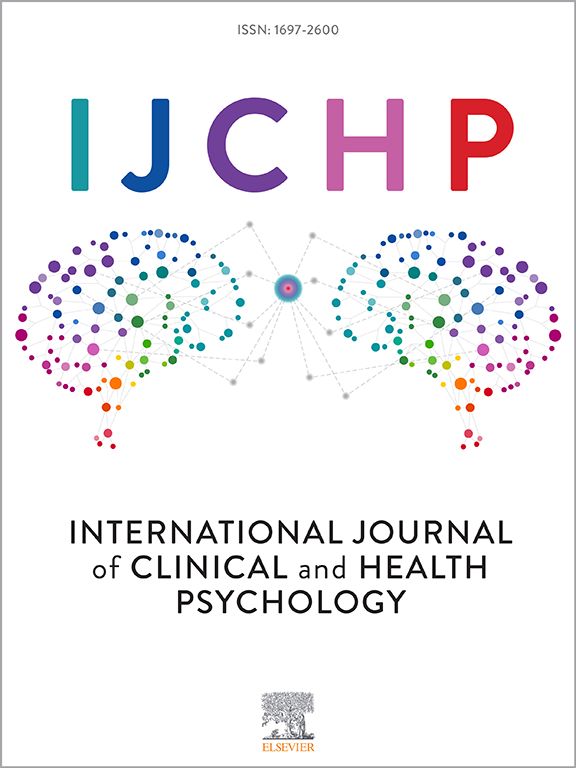Exploring the role of rhythmic music and embodied interaction in interpersonal synchrony and prosocial behaviors in children: The Moving Mandala mixed reality experience
IF 4.4
1区 心理学
Q1 PSYCHOLOGY, CLINICAL
International Journal of Clinical and Health Psychology
Pub Date : 2025-09-24
DOI:10.1016/j.ijchp.2025.100622
引用次数: 0
Abstract
Interpersonal synchrony (IPS), the temporal alignment of behaviors between individuals, fosters social bonding, cooperation, and sharing in children. These prosocial outcomes make IPS a promising mechanism to support social inclusion and psychological well-being, particularly in therapeutic and educational contexts where strengthening peer interaction is essential. However, most IPS interventions rely on static dyadic tasks that lack playfulness and ecological validity, limiting their generalization to real-world environments. Advances in Mixed Reality (MR) offer new possibilities for designing more natural and embodied IPS experiences. Nevertheless, it remains unclear which specific design elements are most effective in eliciting synchrony that fosters prosocial outcomes in group-based settings. This study introduces The Moving Mandala, a playful Mixed Reality experience designed to foster real-time synchrony among four children (ages 8–10) through audiovisual cues and embodied interaction. In a between-subjects study with 268 children, participants were randomly assigned to one of four conditions: “no prior movement” (Baseline), “asynchronous and non-rhythmic ambient music” (Control), “synchronous and rhythmic music” (Experimental 1), and “synchronous and non-rhythmic ambient music” (Experimental 2). The study tested: (i) whether rhythmic auditory stimuli enhance IPS compared to non-rhythmic ambient sound, and (ii) whether synchronous movements facilitate prosocial behavior and social bonding compared to asynchronous and no prior (baseline) movements. Results showed that rhythmic music significantly improved synchrony performance, confirming its role as a temporal scaffold. However, no significant differences in prosocial behavior or social bonding were found between conditions. Design choices such as limited mutual dependency and high cognitive load may have reduced the salience of interpersonal cues. These findings highlight both the potential and challenges of using MR to promote synchrony-based social outcomes. By identifying key design elements, this work contributes to the development of engaging socially supportive MR interventions for children, with potential applications in therapeutic, educational, and rehabilitative contexts.
探索节奏音乐和具身互动在儿童人际同步性和亲社会行为中的作用:移动曼陀罗混合现实体验
人际同步(IPS),个体之间行为的时间一致性,促进了儿童的社会联系、合作和分享。这些亲社会结果使IPS成为支持社会包容和心理健康的有希望的机制,特别是在加强同伴互动至关重要的治疗和教育环境中。然而,大多数IPS干预依赖于静态二元任务,缺乏趣味性和生态有效性,限制了它们在现实世界环境中的推广。混合现实(MR)的进步为设计更自然、更具体的IPS体验提供了新的可能性。然而,目前尚不清楚哪些特定的设计元素最有效地激发同步性,从而在基于群体的环境中促进亲社会结果。本研究介绍了“移动的曼陀罗”,这是一个有趣的混合现实体验,旨在通过视听线索和具体互动促进四个孩子(8-10岁)的实时同步。在一项有268名儿童参与的受试者间研究中,参与者被随机分配到四种条件中的一种:“没有预先动作”(基线)、“异步和无节奏的环境音乐”(对照组)、“同步和有节奏的音乐”(实验1)和“同步和无节奏的环境音乐”(实验2)。该研究测试了:(1)与无节奏的环境声音相比,有节奏的听觉刺激是否能增强IPS;(2)与异步和无先验(基线)运动相比,同步运动是否能促进亲社会行为和社会联系。结果表明,节奏音乐显著提高了同步性表现,证实了其作为时间支架的作用。然而,在不同条件下,亲社会行为和社会联系没有显著差异。有限的相互依赖和高认知负荷等设计选择可能降低了人际线索的显著性。这些发现强调了使用MR促进基于同步的社会结果的潜力和挑战。通过确定关键的设计元素,这项工作有助于为儿童提供社会支持的磁共振干预措施的发展,在治疗、教育和康复方面具有潜在的应用前景。
本文章由计算机程序翻译,如有差异,请以英文原文为准。
求助全文
约1分钟内获得全文
求助全文
来源期刊

International Journal of Clinical and Health Psychology
PSYCHOLOGY, CLINICAL-
CiteScore
10.70
自引率
5.70%
发文量
38
审稿时长
33 days
期刊介绍:
The International Journal of Clinical and Health Psychology is dedicated to publishing manuscripts with a strong emphasis on both basic and applied research, encompassing experimental, clinical, and theoretical contributions that advance the fields of Clinical and Health Psychology. With a focus on four core domains—clinical psychology and psychotherapy, psychopathology, health psychology, and clinical neurosciences—the IJCHP seeks to provide a comprehensive platform for scholarly discourse and innovation. The journal accepts Original Articles (empirical studies) and Review Articles. Manuscripts submitted to IJCHP should be original and not previously published or under consideration elsewhere. All signing authors must unanimously agree on the submitted version of the manuscript. By submitting their work, authors agree to transfer their copyrights to the Journal for the duration of the editorial process.
 求助内容:
求助内容: 应助结果提醒方式:
应助结果提醒方式:


